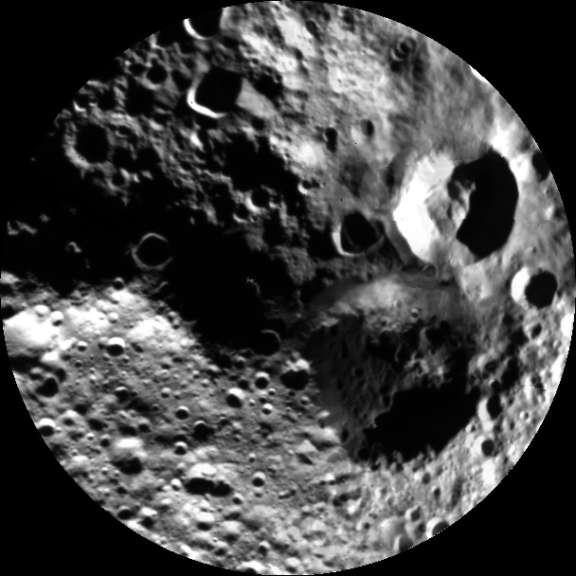All
All
Stories, updates, insights, and original analysis from The Planetary Society.
VIDEOS: Nye & Teens in Space as Curiosity Lands in Hi-Def!
Losing your enthusiasm for space exploration and science Watch these new and terrific videos for an exhilarating shot of Vitamin S.
Spring arrives to Vesta's north pole, as Dawn departs, plus a request for citizen scientists
Dawn's last images of Vesta peek into previously shadowy north polar territory. As the spacecraft leaves Vesta behind, its science team requests help from the public.
Thursday: Watch Bill Nye Host YouTube SpaceLab Webcast
The Planetary Society CEO goes to London to MC a live conversation with ISS astronaut Sunita Williams and the kids who've had their experiments conducted in orbit.
NITARP seeks educators for NASA astronomy research
NITARP seeks educators interested in teaming up with NASA astronomers to perform genuine astronomical research.
Lockheed Martin Launches Innovate the Future Challenge
The aerospace giant wants your great ideas that may help create a better future. Winners will receive cash prizes totaling up to $50,000, but you must submit your concept by September 30! Here are more details from the company's Acting Director of Innovation.
Something New! Uwingu
A start-up company creating products that will fund space exploration, research, and education.
Celestron Video From USA Science & Engineering Festival
Telescope maker Celestron joined the Planetary Society at April's big festival in Washington. Their new video about the experience features our Emily Lakdawalla.
Moon Mappers citizen science project now public, and statistics show it works!
Last week, Pamela Gay of CosmoQuest announced that their Moon Mappers citizen science project is out of its beta phase and ready for prime time. Moon Mappers enlists the help of the public to perform the gargantuan task of mapping the sizes and positions of craters photographed on the Moon by Lunar Reconnaissance Orbiter. Crater counting is the most powerful tool geologists have for figuring out how old planetary surfaces are. But when you have Terabytes of data, it's simply impossible for one scientist to count all the craters
Hey amateurs! ESA's running an image processing contest: "Hubble's Hidden Treasures!"
Here's a newly announced contest that is right up my alley and, I hope, of interest to regular readers of this blog. ESA has just announced
Adventures in urban astrophotography
Just because you live in an urban area with skyglow doesn't mean you can't have fun with astrophotography. How to capture the planets, constellations and the ISS.
What do we know about planetary rings? Quite a lot, actually!
A summary of a new article by Matt Tiscareno about planetary ring systems that reviews the known ring systems of the four giant planets and the prospects for ring systems yet to be discovered.
The most exciting citizen science project ever (to me, anyway)
A guest blogger here recently rounded up the large number of participatory research projects that are collectively known as citizen science. I think these are all very cool and I encourage you to check them out but none of them has yet inspired me to spend my precious time as grunt labor on a gigantic collective project. Until now.
SETI@home Following Up on Kepler Discoveries
Remember SETI@home? The ground-breaking computing project is now taking a look at candidate Earth-like planets that have been detected by NASA's Kepler space telescope.
Citizen Science projects for Planetary Science: Get Involved! Do Science!
Citizen Science projects let volunteers easily contribute to active science programs. They're useful when there is so much data it overwhelms computing algorithms (if they exist) or the scientific research team attempting to process it.
Lovely crater turns up in MoonZoo; 2 million images classified, lots more Moon left
Here's a very pretty picture to start off the week: a really gorgeous fresh crater on the lunar farside. There's nothing particularly unusual about this crater; it's just recent and fresh so there's a mesmerizing amount of detail in the feathery patterns of the ejecta that fans outward from it.
LPSC 2011: Day 3: Moon, Mars, and Venus
Wednesday morning included some interesting conversations. Notably, I spoke with Pamela Gay, who is responsible for the MoonZoo citizen science program and who is presently working on developing a site through which the public will be able to help search for potential Kuiper belt objects for the New Horizons mission to encounter after the Pluto flyby.
Map the world's light pollution by participating in GLOBE at Night
Now in its sixth year, GLOBE at Night is a citizen science program that marshals the eyes of thousands of people around the world once a year to assess the degree to which light pollution diminishes our views of starry skies.
Help to hunt for planets!
The Planet Hunters website, like Zooniverse's other projects, is very, very easy to get up and running.
Bringing MOLA altimetry tracks into Google Mars
I've had a fun morning of noodling around learning how to write KML files, and have produced one for Google Mars that shows you all of the Mars Orbiter Laser Altimeter tracks that cross the area Opportunity has driven through already, as well as the area of Endeavour crater.
New Pulsar Discovery Shows Power of Citizen Scientists and Planetary Society Members
Planetary Society members have reason to celebrate today, with the on-line publication in Science of the discovery of a new pulsar by three citizen-scientists working with Einstein@home, a descendant of the SETI@home project.


 Explore Worlds
Explore Worlds Find Life
Find Life Defend Earth
Defend Earth


 Sun
Sun Mercury
Mercury Venus
Venus Earth
Earth Mars
Mars Jupiter
Jupiter Saturn
Saturn Uranus
Uranus Neptune
Neptune Small Bodies
Small Bodies















